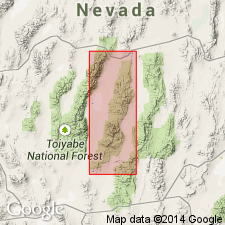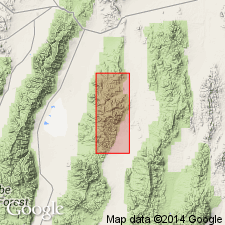
- Usage in publication:
-
- Joes Canyon Formation
- Modifications:
-
- First used
- Dominant lithology:
-
- Siltstone
- AAPG geologic province:
-
- Great Basin province
Summary:
[Name Joes Canyon used in diagram by Kay (1960)]. Joes Canyon Formation is listed as youngest formation (of 4) of Clipper Canyon Group. Is dominantly buff-weathering, dark, argillaceous quartz siltstone some 300 ft thick. Overlies Sams Spring Formation of Clipper Canyon Group. Age of Clipper Canyon Group is given as Ordovician based on graptolites in Petes Summit Formation (new) and Sams Spring Formation within group.
Source: GNU records (USGS DDS-6; Menlo GNULEX).

- Usage in publication:
-
- Joes Canyon Formation
- Modifications:
-
- Named
- Dominant lithology:
-
- Siltstone
- AAPG geologic province:
-
- Great Basin province
Summary:
Is poorly exposed on slopes 1 mi south-southwest of Petes Spring, west of Joes Canyon trail, Toquima Range, Lander Co, NV. Is youngest formation (of 4) of Clipper Canyon Group (new). Shown on map of Petes Summit Sheet, Nye and Lander Cos, NV. There are few exposures of Joes Canyon Formation, and succession is invariably terminated by faults. Consists of brownish to buff platy fragments of argillaceous quartz siltstone. Is about 300 ft thick. Overlies Sams Spring Formation (new) (of Clipper Canyon Group). Age is not known on direct evidence. Presumably age is Ordovician although highest fossils in underlying beds are in lower part of Sams Spring Formation.
Source: GNU records (USGS DDS-6; Menlo GNULEX).
For more information, please contact Nancy Stamm, Geologic Names Committee Secretary.
Asterisk (*) indicates published by U.S. Geological Survey authors.
"No current usage" (†) implies that a name has been abandoned or has fallen into disuse. Former usage and, if known, replacement name given in parentheses ( ).
Slash (/) indicates name conflicts with nomenclatural guidelines (CSN, 1933; ACSN, 1961, 1970; NACSN, 1983, 2005, 2021). May be explained within brackets ([ ]).

